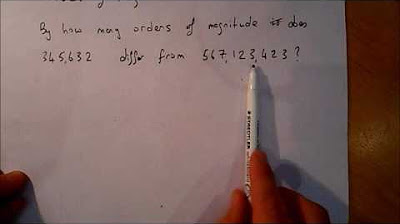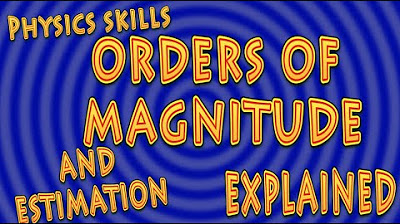Order of Magnitude
TLDRThe video script introduces the concept of order of magnitude, emphasizing its relationship with scientific notation. It explains how to convert numbers into scientific notation, and then determine their order of magnitude by observing the exponent of 10. The video provides examples, such as converting 1.2 x 10^3 and 320,000 into scientific notation, and then comparing their magnitudes. It challenges viewers to identify the order of magnitude for given numbers, highlighting the importance of maintaining the sign (positive or negative) in the exponent. The goal is to deepen understanding of these mathematical concepts and their practical applications.
Takeaways
- 📚 Understanding order of magnitude requires knowledge of scientific notation.
- 🔢 'To the power of' notation magnifies a number by multiplying it by itself a certain number of times.
- 🤔 For example, 10 to the power of 3 equals ten times ten times ten, which is 1,000.
- 🧠 Converting a large number like 320,000 into scientific notation moves the decimal place 5 steps back, resulting in 3.2 times 10 to the power of 5.
- 📈 The order of magnitude is the exponent on the 10 in scientific notation, showing how many times the number is multiplied by 10.
- 🔍 To find the difference in order of magnitude between two numbers, subtract their exponents.
- 🌟 For instance, 3.2 times 10 to the power of 5 is 100 times larger than 1.2 times 10 to the power of 3.
- ✍️ When converting numbers to scientific notation, the order of magnitude is determined by the number of places the decimal point is moved.
- 📊 A negative order of magnitude, like 2.1 times 10 to the power of negative 4, indicates a very small number.
- 📈 To convert a number to scientific notation, move the decimal point to the right of the first non-zero digit, and the number of places moved is the exponent.
- 📝 The order of magnitude helps in comparing the relative sizes of different numbers and understanding their scale.
Q & A
What is the main topic of the video?
-The main topic of the video is the concept of order of magnitude and its relationship with scientific notation.
How does the number 1.2 times 10 to the power of 3 demonstrate the concept of magnification?
-The number 1.2 times 10 to the power of 3 demonstrates magnification by showing that the 1.2 is multiplied by a thousand (10 to the power of 3), thus making the number 1200, which is a thousand times larger than the original 1.2.
What is the process for converting the number 320,000 into scientific notation?
-To convert 320,000 into scientific notation, you move the decimal place 5 positions to the left, resulting in 3.2 times 10 to the power of 5.
How can you determine the difference in order of magnitude between two numbers?
-You can determine the difference in order of magnitude by subtracting the exponent of the smaller number from the exponent of the larger number. For example, 10 to the power of 5 minus 10 to the power of 3 equals 10 to the power of 2, which is a difference of 100 times.
What is the order of magnitude for the number 620?
-The order of magnitude for the number 620 is 2, because when you convert it to scientific notation, it becomes 6.2 times 10 to the power of 2.
How does the order of magnitude for a number in scientific notation relate to the position of the decimal point?
-The order of magnitude for a number in scientific notation is directly related to the position of the decimal point. The decimal point is moved to the right or left to create a number between 1 and 10, and the number of positions moved is the order of magnitude.
What is the order of magnitude for the number 4 million?
-The order of magnitude for the number 4 million is 6, because when converted to scientific notation, it is written as 4.0 times 10 to the power of 6.
How does a negative exponent affect the order of magnitude?
-A negative exponent indicates a smaller value and thus a smaller order of magnitude. For example, 2.1 times 10 to the power of negative 4 has an order of magnitude of -4.
What is the order of magnitude for the number 9.9999?
-The order of magnitude for the number 9.9999 is 2, as it can be expressed in scientific notation as 9.9999 times 10 to the power of 2.
Why is it important to keep the sign (positive or negative) when determining the order of magnitude?
-It is important to keep the sign when determining the order of magnitude because it indicates the relative size of the number. A negative order of magnitude indicates a number that is a fraction of the base (in this case, 10), while a positive order of magnitude indicates a number that is a multiple of the base.
What is the purpose of understanding order of magnitude in scientific notation?
-Understanding order of magnitude in scientific notation is crucial for comparing the relative sizes of very large or very small numbers, which is often necessary in scientific and engineering calculations.
Outlines
📚 Introduction to Order of Magnitude and Scientific Notation
This paragraph introduces the concept of order of magnitude, emphasizing the importance of understanding scientific notation as a foundation. The speaker, Miss Optic, provides an example of how scientific notation works by explaining the magnification of numbers using powers of ten. The video also references another video in the description for further clarification on scientific notation. The process of converting large numbers into scientific notation is demonstrated, highlighting the significance of the exponent in determining the magnitude of a number.
Mindmap
Keywords
💡Order of Magnitude
💡Scientific Notation
💡Exponent
💡Decimal Place
💡Magnitude
💡Conversion
💡Negative Exponent
💡Power of 10
💡Comparison
💡Coefficient
💡Simplification
Highlights
Introduction to the concept of order of magnitude.
The necessity of understanding scientific notation to grasp order of magnitude.
Explanation of how to multiply a number by a power of ten (e.g., 1.2 times 10 to the power of 3 equals 1200).
Conversion of a large number (320,000) into scientific notation (3.2 times 10 to the power of 5).
Comparison of the magnification of two numbers using powers of ten.
Calculation of the difference in powers to determine the relative size of numbers (e.g., 10 to the power of 5 minus 10 to the power of 3 equals 100 times bigger).
Exercise for viewers to practice determining the order of magnitude for given numbers.
Conversion of 620 into scientific notation (6.2 times 10 to the power of 2) and its corresponding order of magnitude (2).
Conversion of 4 million into scientific notation (4.0 times 10 to the power of 6) and its corresponding order of magnitude (6).
Explanation of how to handle negative powers in scientific notation (e.g., 2.1 times 10 to the power of negative 4) and its corresponding order of magnitude (negative 4).
Adjusting the decimal place to determine the order of magnitude for a number like 9.9999 (resulting in 9.9999 times 10 to the power of 2 and an order of magnitude of 2).
The importance of maintaining the sign (positive or negative) when dealing with orders of magnitude.
The practical application of order of magnitude in comparing and understanding the relative sizes of different numbers.
The method of jumping decimal places to convert numbers into scientific notation for the purpose of calculating order of magnitude.
The significance of the small number above the 10 in scientific notation as the order of magnitude.
The process of determining the order of magnitude through scientific notation is emphasized for clarity and understanding.
Transcripts
5.0 / 5 (0 votes)
Thanks for rating:





